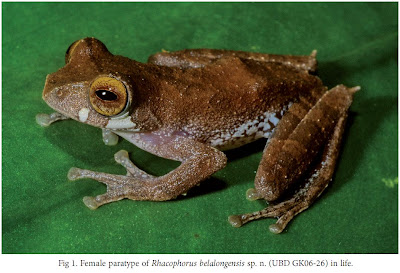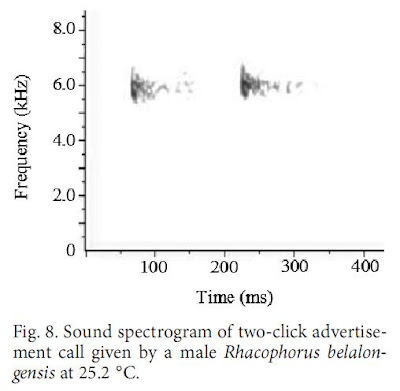
Fig 1. Female paratype of Rhacophorus belalongensis sp. n. (UBd GK06-26) in life.
Abstract
A new species of Rhacophorus from the Sultanate of Brunei darussalam (Borneo) is described. Rhacophorus belalongensis sp. n. is similar to Rhacophorus bimaculatus, R. catamitus, R. gadingensis, and R. gauni, but can be distinguished from these species and all other Southeast Asian members of the genus by the combination of the following characters: small size (SVl of adult females and males 34.7-38.2 mm and 25.8-30.9 mm, respectively), snout obtuse, head wider than long and wider than body, row of small white tubercles but no dermal lap along forearm, pointed calcar present on heel, supratympanic fold weakly expressed or absent, tympanum diameter one-third of that of eye, canthus rostralis sharp, interorbital distance equals upper eyelid width and internarial distance, dorsum grey to light brown in life, more or less regularly speckled with small dark brown irregularly shaped spots, lanks and anterior surface of thighs with irregularly shaped sky blue blotches on lanks, iris ruby-coloured, difusing to yellow laterally with distinct black ring along margin. Furthermore, characteristics of the advertisement call and natural history notes are provided.
Key words: Amphibia, Anura, Rhacophoridae, Rhacophorus belalongensis sp. n., taxonomy, natural history, advertisement call, Brunei darussalam, Borneo.

Rhacophorus belalongensis sp. n. (Figs. 1-7)
Holotype: ZMB 70377, adult female, from Sungai Anak Esu, a tributary of Sungai Belalong (4°32’34’’N, 115° 09’33’’E, ca. 60-200 m elevation), near Kuala Belalong Field Studies Centre, Temburong district, Brunei darussalam (Borneo), collected by T.U. Grafe and A. Keller, 10 July 2006.
Distribution: The new species is known only from several small tributaries of both Sungai Belalong and Sungai Temburong in the area of the conluence of the two rivers.
Etymology: The new species is named after the Sungai Belalong valley, where it was discovered.

Fig. 3. Female paratype of Rhacophorus belalongensis sp. n. (UBd GK06-25) perching on a newly built foam nest.
Belalong tree frog | Rhacophorus belalongensis
BorneoNewWorld-2010 via WWF
As a result of the Heart of Borneo declaration, 58 percent of Brunei Darussalam’s national territory will fall under some level of environmental protection, good news for new species such as the Belalong tree frog, Rhacophorus belalongensis, discovered in 2008. This species was discovered in the Sungai Belalong basin in the Temburong district, hence its name, and it is miniature: males barely measure more than 3cm and females usually less than 3.8cm species. The species was encountered in the rainforests of Brunei, where it was found on vegetation next to small, fast-flowing creeks at heights between one and three metres above the ground. Scientists also heard the frog calling from the very tops of trees up to 10m high.

Fig. 8. Sound spectrogram of two-click advertisement call given
by a male Rhacophorus belalongensis at 25.2 °C.
Dehling, J. M. & T. U. Grafe. 2008. A new treefrog of the genus Rhacophorus (Anura: Rhacophoridae) from Brunei Darussalam (Borneo). Salamandra, 44(2): 101-112.

















































